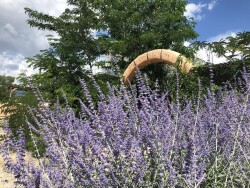

Russian sage (Perovskia atriplicifolia) is a perfectly well-adapted plant from Afghanistan, Pakistan, and Central Asia. It is the perfect match to hot Kansas summers, cold winters, rocky alkaline soils, and drought. Fine-textured foliage is upright and shrub-like consisting of a mint green to blush green color. Lavender to bluish flowers emerging in mid-summer are extremely long-lasting. In fall, Russian sage foliage dies back with the first hard freeze and becomes a whitish-gray color adding awesome winter interest. Imagine this combined with ornamental grasses or bright winter-colored plants like Color Guard Yucca. The only maintenance is cutting the plant back to you about 6 to 8 inches in the spring. New buds emerge from the root system and lower parts of the woody growth. New cultivars of Russian sage do not spread by rhizomes like the species. Russian sage thrives in dry well-drained soils with plenty of full sun and air circulation. They are suitable for hot west or south exposures, berms, parking lot islands, hell strips along roads, and other inhospitable locations. They tolerate poor soil including rock, sand, clay, and alkalinity. They do not tolerate poor drainage and will be floppy even in part shade. Russian sage flowers are highly attractive to honeybees. There are several improved cultivars with improved blooming, improved growth habit, and elimination of spreading.


Russian sage (Perovskia atriplicifolia) is a perfectly well-adapted plant from Afghanistan, Pakistan, and Central Asia. It is the perfect match to hot Kansas summers, cold winters, rocky alkaline soils, and drought. Fine-textured foliage is upright and shrub-like consisting of a mint green to blush green color. Lavender to bluish flowers emerging in mid-summer are extremely long-lasting. In fall, Russian sage foliage dies back with the first hard freeze and becomes a whitish-gray color adding awesome winter interest. Imagine this combined with ornamental grasses or bright winter-colored plants like Color Guard Yucca. The only maintenance is cutting the plant back to you about 6 to 8 inches in the spring. New buds emerge from the root system and lower parts of the woody growth. New cultivars of Russian sage do not spread by rhizomes like the species. Russian sage thrives in dry well-drained soils with plenty of full sun and air circulation. They are suitable for hot west or south exposures, berms, parking lot islands, hell strips along roads, and other inhospitable locations. They tolerate poor soil including rock, sand, clay, and alkalinity. They do not tolerate poor drainage and will be floppy even in part shade. Russian sage flowers are highly attractive to honeybees. There are several improved cultivars with improved blooming, improved growth habit, and elimination of spreading. Blue Jean Baby Russian Sage (Perovskia atriplicifolia 'Blue Jean Baby') is a wonderful compact, non-spreading, and non-flopping variety. Lavender blue flowers held in smoky purple calyxes bloom for a long period starting in midsummer, with the color from the calyxes extending appeal into fall. Blue Jean Baby a Walters Gardens Inc. introduction.


Russian sage (Perovskia atriplicifolia) is a perfectly well-adapted plant from Afghanistan, Pakistan, and Central Asia. It is the perfect match to hot Kansas summers, cold winters, rocky alkaline soils, and drought. Fine-textured foliage is upright and shrub-like consisting of a mint green to blush green color. Lavender to bluish flowers emerging in mid-summer are extremely long-lasting. In fall, Russian sage foliage dies back with the first hard freeze and becomes a whitish-gray color adding awesome winter interest. Imagine this combined with ornamental grasses or bright winter-colored plants like Color Guard Yucca. The only maintenance is cutting the plant back to you about 6 to 8 inches in the spring. New buds emerge from the root system and lower parts of the woody growth. New cultivars of Russian sage do not spread by rhizomes like the species. Russian sage thrives in dry well-drained soils with plenty of full sun and air circulation. They are suitable for hot west or south exposures, berms, parking lot islands, hell strips along roads, and other inhospitable locations. They tolerate poor soil including rock, sand, clay, and alkalinity. They do not tolerate poor drainage and will be floppy even in part shade. Russian sage flowers are highly attractive to honeybees. There are several improved cultivars with improved blooming, improved growth habit, and elimination of spreading. "Tough as steel! A new seed introduction by PanAm Seed with a sturdy, controlled habit in the landscape. 'Blue Steel' combines the best summer-blooming lavender-blue colour with outstanding late-season garden performance and has aromatic, silvery foliage carrying clouds of small blue flowers on strong silver stems that do not break or split easily. It is very hardy and Heat/drought tolerant." - PanAm Seed
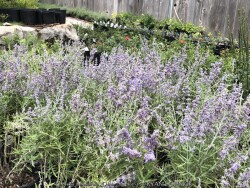

Russian sage (Perovskia atriplicifolia) is a perfectly well-adapted plant from Afghanistan, Pakistan, and Central Asia. It is the perfect match to hot Kansas summers, cold winters, rocky alkaline soils, and drought. Fine-textured foliage is upright and shrub-like consisting of a mint green to blush green color. Lavender to bluish flowers emerging in mid-summer are extremely long-lasting. In fall, Russian sage foliage dies back with the first hard freeze and becomes a whitish-gray color adding awesome winter interest. Imagine this combined with ornamental grasses or bright winter-colored plants like Color Guard Yucca. The only maintenance is cutting the plant back to you about 6 to 8 inches in the spring. New buds emerge from the root system and lower parts of the woody growth. New cultivars of Russian sage do not spread by rhizomes like the species. Russian sage thrives in dry well-drained soils with plenty of full sun and air circulation. They are suitable for hot west or south exposures, berms, parking lot islands, hell strips along roads, and other inhospitable locations. They tolerate poor soil including rock, sand, clay, and alkalinity. They do not tolerate poor drainage and will be floppy even in part shade. Russian sage flowers are highly attractive to honeybees. There are several improved cultivars with improved blooming, improved growth habit, and elimination of spreading. Denim 'n Lace Russian Sage(Perovskia atriplicifolia 'Denim 'n Lace') is a wonderful non-spreading, non-flopping variety. This is the perfect addition to a garden in hot, dry areas. Lacy-like, bright sky blue flowers are held on amethyst calyxes, with strong stems and an upright habit. The beautiful color will last a long time! All Proven Winners® plants are legally propagated, healthy and vigorous, true to name, and tagged with color pictures and growing information.
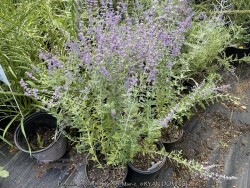

Russian sage (Perovskia atriplicifolia) is a perfectly well-adapted plant from Afghanistan, Pakistan, and Central Asia. It is the perfect match to hot Kansas summers, cold winters, rocky alkaline soils, and drought. Fine-textured foliage is upright and shrub-like consisting of a mint green to blush green color. Lavender to bluish flowers emerging in mid-summer are extremely long-lasting. In fall, Russian sage foliage dies back with the first hard freeze and becomes a whitish-gray color adding awesome winter interest. Imagine this combined with ornamental grasses or bright winter-colored plants like Color Guard Yucca. The only maintenance is cutting the plant back to you about 6 to 8 inches in the spring. New buds emerge from the root system and lower parts of the woody growth. New cultivars of Russian sage do not spread by rhizomes like the species. Russian sage thrives in dry well-drained soils with plenty of full sun and air circulation. They are suitable for hot west or south exposures, berms, parking lot islands, hell strips along roads, and other inhospitable locations. They tolerate poor soil including rock, sand, clay, and alkalinity. They do not tolerate poor drainage and will be floppy even in part shade. Russian sage flowers are highly attractive to honeybees. There are several improved cultivars with improved blooming, improved growth habit, and elimination of spreading. Here's a Russian Sage (Perovskia atriplicifolia 'Rocketman') that doesn't get too tall, has stronger stems and a more upright habit than most. Its aromatic, grey-green leaves are entirely like those of 'Little Spire', clinging to the silvery stems. Each stem is topped with large, fluffy textured, lavender blue flowers beginning in midsummer. Like most Perovskias, the colorful calyxes remain on the stems long after the flowers are spent, making it look like it is still blooming long after it is actually done. You'll have great color on this plant from about July through October in the Midwest. A perfect perennial for hot, dry climates and also exceptionally cold hardy. Perovskia can be used in a wide variety of environments with little attention through the season - a reason they have long been a staple of landscapers. Expect these plants to be a little later to emerge in spring, but also to offer color well into fall. Rocketman Russian Sage is a Walters Gardens Inc. introduction.
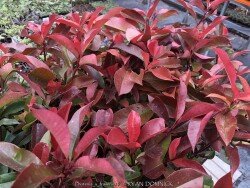

>>>>>Repeated or successive cold winters with complete foliage loss seem to be an issue with this and many evergreen zone 6/7 plants. One occasional difficult winter followed by mild winters is more tolerable. This is, however, a very vigorous growing plant so generally will recover in one summer with decent watering and fertilizer.
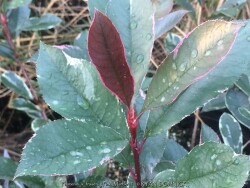

>>>>>Repeated or successive cold winters with complete foliage loss seem to be an issue with this and many evergreen zone 6/7 plants. One occasional difficult winter followed by mild winters is more tolerable. This is, however, a very vigorous growing plant so generally will recover in one summer with decent watering and fertilizer.
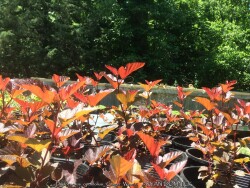

Ginger Wine® Ninebark (Physocarpus opulifolius 'Ginger Wine') expands the color palette for these easy care, native flowering shrubs. Spring foliage emerges a sunny orange color and matures to sparkling burgundy. Clusters of white flowers cover the plant in late spring, and these age to attractive red seed heads. This disease-resistant shrub does best in full sun locations and cooler climates. Top reasons to grow Ginger Wine® ninebark: 1.Colorful from spring through fall. 2. Native to North America. 3. Very low maintenance: no pruning or deadheading required. Ultra cold-hardy plants from northern climates normally dislike our long hot humid summers; although we are on the Southern edge of this plants adaptability, it still survives reasonably well here. It will not handle extreme drought; the Lawrence KS summer of 2011 and 2012 killed many plants that were not under an irrigation system. Look for a cold microclimate planting location such as East or North exposure but still in full sun. All Proven Winners® plants are legally propagated, healthy and vigorous, true to name, and tagged with color pictures and growing information.
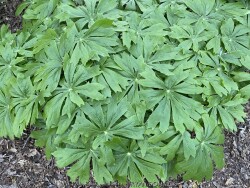

Mayapple (Podophyllum peltatum) is a spring growing perennial with large green umbrella like leaves. White five petal flowers appear on mature plants with green "apple-like" fruits to follow. Mayapple is native to rich woodland areas in Kansas, the Midwest, and most of the eastern United States; it needs rich well-drained soils. Mayapple colonizes by rhizomes forming dense slow-spreading mats making this an easy plant to spot from a distance especially in the early spring. Early spring emergence is normally not a problem as foliage resists normal spring frosts. During the April deep freeze of 2007 in Lawrence, KS, temperatures bottomed out at 18°F after an extra warm March. As a comparison, hosta foliage had completely unfurled was killed to the ground but Mayapple foliage had no damage for several days of the cold blast with temperatures down to 22-24°F! Moderate damage occurred on the last night at 18°F but no long term problems persisted. After summer heat and drought sets in usually by mid June, the foliage disappears completely going dormant until the next spring. Because it goes dormant, summer drought is usually not a problem as long as soil is rich in organic matter and moisture-retentive. Fruit-set is uncommon as vegetative growth is the primary method of propagation. A single-leafed stem will not produce a flower that season. A forked stems bearing two leaves will have a tight flower bud nestled at the base of the two petioles and possible fruit if pollinated. Bees seem to do this work, especially queen bumble bees. Blooms occur at a time of year when other pollen sources are rare thus being very valuable for wild-life. Fruit is sweet and edible, however with caution. Usually one or two fruits is safe but toxic if eaten in larger quantities. Usually, raccoons or possums get to the fruit before humans. This native perennial gives a tropical vibe and is valuable for the early spring foliage, flower, and fruit but be prepared for a bare spot during the rest of summer unless you fill in with summer annuals, late emerging perennials, or mulch to stop weed growth.
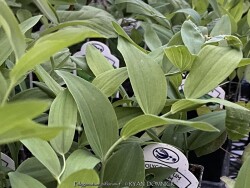

Solomon Seal (Polygonatum sp.) is a very large genus of perennials comprising dozens of species. Many of the species that are appropriate for garden use in Kansas are native to seasonally dry to moist forests in North America and Asia. New growth arises each year from a finger-like slowly spreading rhizome system. The foliage has a central stem with architecturally arranged opposite leaves covering the length of the stem gradually getting smaller towards the end. Small bell-shaped white flowers appear in early spring followed by bluish-purple fruit. Flowers and new spring growth is frost-hardy. Most Solomon seals do well with average garden soils and moisture with many tolerating dry-shade well. Solomon's seal can grow for many years increasing in density without ever needing division. Over time this creates a nearly weed-proof groundcover. in eastern Kansas with 40 inches of rain per year on average, there seems to be plenty of moisture to create extremely healthy patches of Solomon seal that compete well with tree roots. While some species can tolerate sun, there are many better choices as sunburning will likely occur with afternoon sun in temperatures over 95 degrees F. Combine with hostas or other shade plants to create a dramatic effect. Included in our "edibles" database but depends on how hungry you are! Polygonatum biflorum, also known as Smooth solomon's-seal, is native to Kansas and Central U.S. forests in average to moist conditions including dry-shade. It adds a bright splash of light green to the shade garden. Fruiting does occur and desirable self-seeding occurs within the patch. Plants reach heights of 18-24" tall in Kansas. Fall color is a brilliant yellow for a week before going dormant. Maintenance is easy as stems easily detach when raking with fall clean-up. If cosmetic foliage leaf-rust is a problem, just cut back early. During the April deep freeze of 2007, temperatures bottomed out at 18°F after an extra warm March. Hosta and Solomon seal foliage had completely unfurled and was flowering. All hostas were killed to the ground but solomon seal foliage and flowers survived un-damaged! A great "Once it's there, it's there forever" plant for dry-shade!
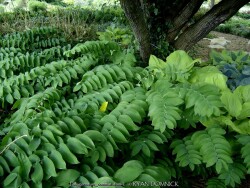

Solomon Seal (Polygonatum sp.) is a very large genus of perennials comprising dozens of species. Many of the species that are appropriate for garden use in Kansas are native to seasonally dry to moist forests in North America and Asia. New growth arises each year from a finger-like slowly spreading rhizome system. The foliage has a central stem with architecturally arranged opposite leaves covering the length of the stem gradually getting smaller towards the end. Small bell-shaped white flowers appear in early spring followed by bluish-purple fruit. Flowers and new spring growth is frost-hardy. Most Solomon seals do well with average garden soils and moisture with many tolerating dry-shade well. Solomon's seal can grow for many years increasing in density without ever needing division. Over time this creates a nearly weed-proof groundcover. in eastern Kansas with 40 inches of rain per year on average, there seems to be plenty of moisture to create extremely healthy patches of Solomon seal that compete well with tree roots. While some species can tolerate sun, there are many better choices as sunburning will likely occur with afternoon sun in temperatures over 95 degrees F. Combine with hostas or other shade plants to create a dramatic effect. Included in our "edibles" database but depends on how hungry you are! Polygonatum commutatum, also known as Great Solomon's seal, is native to Eastern U.S. forests in average to moist conditions. It adds a bright splash of light green to the shade garden. Fruiting does occur and desirable self-seeding occurs within the patch. Plants reach heights of 24-36" tall in Kansas. Fall color is a brilliant yellow for a week before going dormant. Maintenance is easy as stems easily detach when raking with fall clean-up. If cosmetic foliage leaf-rust is a problem, just cut back early. During the April deep freeze of 2007, temperatures bottomed out at 18°F after an extra warm March. Hosta and Solomon seal foliage had completely unfurled and was flowering. All hostas were killed to the ground but solomon seal foliage and flowers survived un-damaged! A great "Once it's there, it's there forever" plant for dry-shade!
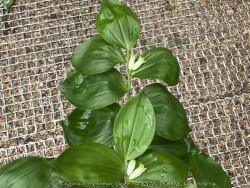

Solomon Seal (Polygonatum sp.) is a very large genus of perennials comprising dozens of species. Many of the species that are appropriate for garden use in Kansas are native to seasonally dry to moist forests in North America and Asia. New growth arises each year from a finger-like slowly spreading rhizome system. The foliage has a central stem with architecturally arranged opposite leaves covering the length of the stem gradually getting smaller towards the end. Small bell-shaped white flowers appear in early spring followed by bluish-purple fruit. Flowers and new spring growth is frost-hardy. Most Solomon seals do well with average garden soils and moisture with many tolerating dry-shade well. Solomon's seal can grow for many years increasing in density without ever needing division. Over time this creates a nearly weed-proof groundcover. in eastern Kansas with 40 inches of rain per year on average, there seems to be plenty of moisture to create extremely healthy patches of Solomon seal that compete well with tree roots. While some species can tolerate sun, there are many better choices as sunburning will likely occur with afternoon sun in temperatures over 95 degrees F. Combine with hostas or other shade plants to create a dramatic effect. Included in our "edibles" database but depends on how hungry you are! Hidden Flower Solomon's Seal (Polygonatum cryptanthum 'Crug') is one of the most attractive solomon seals in our display garden. This species forms a tight clump of slow-spreading rhizomes with bubbly, shiny green foliage 12" tall. Stems feature rows of small, white, clustered bells that do not open fully and are attached just below the leaf intersections. Brilliant blue fruit ripens late summer and fall. Fall color is a brilliant yellow for a week before going dormant. Maintenance is easy as stems easily detach when raking with fall clean-up. If cosmetic foliage leaf-rust is a problem, just cut back early. A great "Once it's there, it's there forever" plant for dry-shade! Rarely available for sale as propagation is slow.
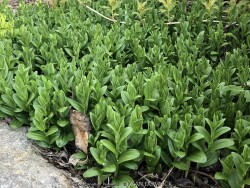

Solomon Seal (Polygonatum sp.) is a very large genus of perennials comprising dozens of species. Many of the species that are appropriate for garden use in Kansas are native to seasonally dry to moist forests in North America and Asia. New growth arises each year from a finger-like slowly spreading rhizome system. The foliage has a central stem with architecturally arranged opposite leaves covering the length of the stem gradually getting smaller towards the end. Small bell-shaped white flowers appear in early spring followed by bluish-purple fruit. Flowers and new spring growth is frost-hardy. Most Solomon seals do well with average garden soils and moisture with many tolerating dry-shade well. Solomon's seal can grow for many years increasing in density without ever needing division. Over time this creates a nearly weed-proof groundcover. in eastern Kansas with 40 inches of rain per year on average, there seems to be plenty of moisture to create extremely healthy patches of Solomon seal that compete well with tree roots. While some species can tolerate sun, there are many better choices as sunburning will likely occur with afternoon sun in temperatures over 95 degrees F. Combine with hostas or other shade plants to create a dramatic effect. Tiny Green Solomon's Seal (Polygonatum humile) is a miniture groundcover solonons seal only 4-8" tall. This cute plant is everything "solomon seal" just miniture! Best growth occurs in average to wet soils in part shade to full shade. Slowly spreading thin rhizomes form a colony in optimum growing conditions. In dry shade, the plant survives but goes dormant by mid-summer paving the way for weeds to come in so avoid these conditions.
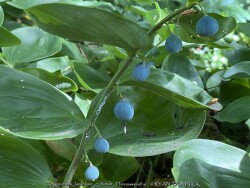

Solomon Seal (Polygonatum sp.) is a very large genus of perennials comprising dozens of species. Many of the species that are appropriate for garden use in Kansas are native to seasonally dry to moist forests in North America and Asia. New growth arises each year from a finger-like slowly spreading rhizome system. The foliage has a central stem with architecturally arranged opposite leaves covering the length of the stem gradually getting smaller towards the end. Small bell-shaped white flowers appear in early spring followed by bluish-purple fruit. Flowers and new spring growth is frost-hardy. Most Solomon seals do well with average garden soils and moisture with many tolerating dry-shade well. Solomon's seal can grow for many years increasing in density without ever needing division. Over time this creates a nearly weed-proof groundcover. in eastern Kansas with 40 inches of rain per year on average, there seems to be plenty of moisture to create extremely healthy patches of Solomon seal that compete well with tree roots. While some species can tolerate sun, there are many better choices as sunburning will likely occur with afternoon sun in temperatures over 95 degrees F. Combine with hostas or other shade plants to create a dramatic effect. Included in our "edibles" database but depends on how hungry you are! Wide-leaf Solomon's Seal (Polygonatum latifolium / hirtum 'Heronswood') is one of the most attractive solomon seals in our display garden. This species forms a tight clump of slow-spreading rhizomes with bubbly, shiny green foliage on stems 12" tall. Stems feature rows of small, white, clustered bells, attached just below the leaf intersections. Brilliant blue fruit ripens late summer and fall. Fall color is a brilliant yellow for a week before going dormant. Maintenance is easy as stems easily detach when raking with fall clean-up. If cosmetic foliage leaf-rust is a problem, just cut back early. A great "Once it's there, it's there forever" plant for dry-shade! Rarely available for sale as propagation is slow.
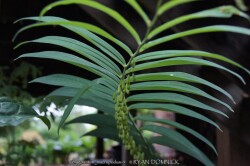

Solomon Seal (Polygonatum sp.) is a very large genus of perennials comprising dozens of species. Many of the species that are appropriate for garden use in Kansas are native to seasonally dry to moist forests in North America and Asia. New growth arises each year from a finger-like slowly spreading rhizome system. The foliage has a central stem with architecturally arranged opposite leaves covering the length of the stem gradually getting smaller towards the end. Small bell-shaped white flowers appear in early spring followed by bluish-purple fruit. Flowers and new spring growth is frost-hardy. Most Solomon seals do well with average garden soils and moisture with many tolerating dry-shade well. Solomon's seal can grow for many years increasing in density without ever needing division. Over time this creates a nearly weed-proof groundcover. in eastern Kansas with 40 inches of rain per year on average, there seems to be plenty of moisture to create extremely healthy patches of Solomon seal that compete well with tree roots. While some species can tolerate sun, there are many better choices as sunburning will likely occur with afternoon sun in temperatures over 95 degrees F. Combine with hostas or other shade plants to create a dramatic effect. Included in our "edibles" database but depends on how hungry you are! Big Footed Solomon's Seal (Polygonatum macropodum) is the largest and most architectural solomon seal in our display garden. This species forms a tight clump of slow-spreading rhizomes with symmetrical foliage upto 4' long. Stems feature long rows of small, white, clustered bells, attached just below the leaf intersections. Blue fruit ripens late summer and fall. Fall color is a brilliant yellow for a week before going dormant. Maintenance is easy as stems easily detach when raking with fall clean-up. If cosmetic foliage leaf-rust is a problem, just cut back early. During the April deep freeze of 2007, temperatures bottomed out at 18°F after an extra warm March. Hosta and Solomon seal foliage had completely unfurled and was flowering. All hostas were killed to the ground but solomon seal foliage and flowers survived un-damaged! A great "Once it's there, it's there forever" plant for dry-shade! Rarely available for sale as propagation is slow.
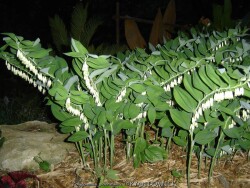

Solomon Seal (Polygonatum sp.) is a very large genus of perennials comprising dozens of species. Many of the species that are appropriate for garden use in Kansas are native to seasonally dry to moist forests in North America and Asia. New growth arises each year from a finger-like slowly spreading rhizome system. The foliage has a central stem with architecturally arranged opposite leaves covering the length of the stem gradually getting smaller towards the end. Small bell-shaped white flowers appear in early spring followed by bluish-purple fruit. Flowers and new spring growth is frost-hardy. Most Solomon seals do well with average garden soils and moisture with many tolerating dry-shade well. Solomon's seal can grow for many years increasing in density without ever needing division. Over time this creates a nearly weed-proof groundcover. in eastern Kansas with 40 inches of rain per year on average, there seems to be plenty of moisture to create extremely healthy patches of Solomon seal that compete well with tree roots. While some species can tolerate sun, there are many better choices as sunburning will likely occur with afternoon sun in temperatures over 95 degrees F. Combine with hostas or other shade plants to create a dramatic effect. Included in our "edibles" database but depends on how hungry you are! Medium Green Japanese Solomon's Seal (Polygonatum odoratum) adds a bright splash of light green to the shade garden. Fruiting does not occur on this variety like others. Height is uniformly 18-24" tall. Fall color is a brilliant yellow for a week before going dormant. Maintenance is easy as stems easily detach when raking with fall clean-up. If cosmetic foliage leaf-rust is a problem, just cut back early. During the April deep freeze of 2007, temperatures bottomed out at 18°F after an extra warm March. Hosta and Solomon seal foliage had completely unfurled and was flowering. All hostas were killed to the ground but solomon seal foliage and flowers survived un-damaged! A great "Once it's there, it's there forever" plant for dry-shade!


Solomon Seal (Polygonatum sp.) is a very large genus of perennials comprising dozens of species. Many of the species that are appropriate for garden use in Kansas are native to seasonally dry to moist forests in North America and Asia. New growth arises each year from a finger-like slowly spreading rhizome system. The foliage has a central stem with architecturally arranged opposite leaves covering the length of the stem gradually getting smaller towards the end. Small bell-shaped white flowers appear in early spring followed by bluish-purple fruit. Flowers and new spring growth is frost-hardy. Most Solomon seals do well with average garden soils and moisture with many tolerating dry-shade well. Solomon's seal can grow for many years increasing in density without ever needing division. Over time this creates a nearly weed-proof groundcover. in eastern Kansas with 40 inches of rain per year on average, there seems to be plenty of moisture to create extremely healthy patches of Solomon seal that compete well with tree roots. While some species can tolerate sun, there are many better choices as sunburning will likely occur with afternoon sun in temperatures over 95 degrees F. Combine with hostas or other shade plants to create a dramatic effect. Included in our "edibles" database but depends on how hungry you are! Ruby Slippers Solomon's Seal (Polygonatum odoratum 'Ruby Slippers') adds a bright splash of light green foliage and ruby-red stems to the shade garden. Height is uniformly 18-24" tall. Fall color is a brilliant yellow for a week before going dormant. Maintenance is easy as stems easily detach when raking with fall clean-up. A great "Once it's there, it's there forever" plant for dry-shade!
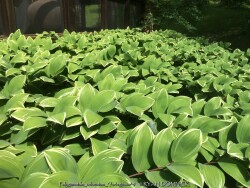

Solomon Seal (Polygonatum sp.) is a very large genus of perennials comprising dozens of species. Many of the species that are appropriate for garden use in Kansas are native to seasonally dry to moist forests in North America and Asia. New growth arises each year from a finger-like slowly spreading rhizome system. The foliage has a central stem with architecturally arranged opposite leaves covering the length of the stem gradually getting smaller towards the end. Small bell-shaped white flowers appear in early spring followed by bluish-purple fruit. Flowers and new spring growth is frost-hardy. Most Solomon seals do well with average garden soils and moisture with many tolerating dry-shade well. Solomon's seal can grow for many years increasing in density without ever needing division. Over time this creates a nearly weed-proof groundcover. in eastern Kansas with 40 inches of rain per year on average, there seems to be plenty of moisture to create extremely healthy patches of Solomon seal that compete well with tree roots. While some species can tolerate sun, there are many better choices as sunburning will likely occur with afternoon sun in temperatures over 95 degrees F. Combine with hostas or other shade plants to create a dramatic effect. Included in our "edibles" database but depends on how hungry you are! Variegated Solomon's Seal (Polygonatum odoratum 'Variegatum') adds a bright splash of light green and cream color to the shade garden. Fruiting does not occur on this variety like others. Height is uniformly 18-24" tall. Fall color is a brilliant yellow for a week before going dormant. Maintenance is easy as stems easily detach when raking with fall clean-up. During the April deep freeze of 2007, temperatures bottomed out at 18°F after an extra warm March. Hosta and Solomon seal foliage had completely unfurled and was flowering. All hostas were killed to the ground but solomon seal foliage and flowers survived un-damaged! A great "Once it's there, it's there forever" plant for dry-shade!
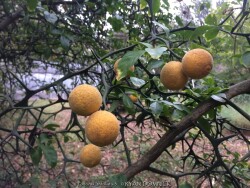

Hardy Orange (Poncirus trifoliata) makes an extremely architectural, well-branched, deciduous shrub with numerous thorns reminding me of the Sleeping Beauty Thorn Forest. One of the hardiest close relative of Citrus, Poncirus trifoliata in native to China and Korea. Hardy Orange makes an excellent privacy hedge for background areas away from foot traffic. Although deciduous, plants grow so dense that is virtually impenetrable. Also effective as an accent specimen in the sense of being an interesting and unusual. The root stock is used for grafting in the citrus industry. Growth requirements are simple; plant in almost any soil in full sun to full shade. As for ornamental qualities, these shrubs are covered with aromatic white flowers in spring followed by "edible" green fruits that turn yellowish orange by fall. Fruits of this citrus relative are edible with a strong lemony flavor but are very acidic and seedy. Fruits can used to make marmalade or left on the shrub where they persist well into winter providing significant ornamental interest. Growth is more open in shade with less flowering and fruits. It survived -16 degrees F and a week of single digit highs in February, 2021 after regrowing from the ground. Oklahoma State University in Stillwater, OK once had dozens of sidewalks lined with trifoliate orange pruned into long perfectly shaped 4'x4' rectangular cuboid. The woody growth was so dense that one could stand on top of this hedge; I personally witnessed this with amazement.


Hardy Orange (Poncirus trifoliata 'Flying Dragon') makes an extremely architectural, well-branched, deciduous shrub with numerous thorns reminding me of the Sleeping Beauty Thorn Forest. One of the hardiest close relative of Citrus, Poncirus trifoliata in native to China and Korea. Hardy Orange makes an excellent privacy hedge for background areas away from foot traffic. Although deciduous, plants grow so dense that is virtually impenetrable. Also effective as an accent specimen in the sense of being an interesting and unusual. The root stock is used for grafting in the citrus industry. Growth requirements are simple; plant in almost any soil in full sun to full shade. As for ornamental qualities, these shrubs are covered with aromatic white flowers in spring followed by "edible" green fruits that turn yellowish orange by fall. Fruits of this citrus relative are edible with a strong lemony flavor but are very acidic and seedy. Fruits can used to make marmalade or left on the shrub where they persist well into winter providing significant ornamental interest. Growth is more open in shade with less flowering and fruits. Oklahoma State University in Stillwater, OK once had dozens of sidewalks lined with trifoliate orange pruned into long perfectly shaped 4'x4' rectangular cuboid. The woody growth was so dense that one could stand on top of this hedge; I personally witnessed this with amazement. In our trial gardens in Lawrence, KS (zone 6a), a well established specimen planted 15 years ago survived -17 degrees F with no damage. Poncirus trifoliata 'Flying Dragon' is a beautiful contorted form of this plant that can best be described as a living piece of sculpture with its weaving branches and twisted thorns. Growth is much slower than the species. During the arctic blast of February, 2021, lows down to -17 degrees F on Feb 16th, 2021 were recorded. The longevity of this cold blast was also impressive: 10 days on a row with highs of 10-15 degrees F or lower, 8 nights of lows in the single digits and negatives, and 36 straight hours of 0 degrees F and mostly lower.
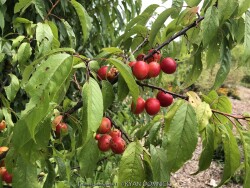

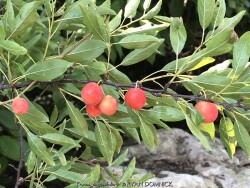

Native Edible Sand Plum, is also known as Prunus angustifolia
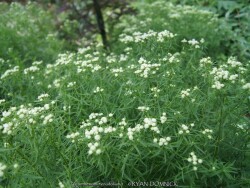

Narrow-Leaf Mountain Mint, is also known as Pycanthemum tenuifolium
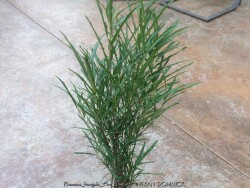

Fine Line Columnar Buckthorn, is also known as Rhamnus frangula 'Fine Line'


Fine Line Columnar Buckthorn, is also known as Rhamnus frangula 'Fine Line'
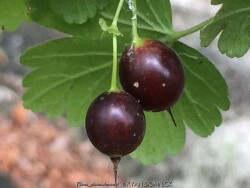

Missouri Gooseberry (Ribes missouriense) is a spreading shrub native to the north central United States including Kansas. It features green leaves that remain attractive all summer. Light yellow to whitish-green flowers are noticeable and attractive upon close inspection. Green semi-translucent berries develop in summer and ripen to a purplish-black color by late summer and early fall. Tart berries are attractive and highly edible when eaten fresh or baked into pies. Any fruits not eaten by humans are harvested by wildlife. Fall color is reddish-orange and will occur in sun or shade. This shrub eventually grows into a dense thicket 3-5' tall with small thorns or prickles. It will grow in part sun or full shade in medium to dry soils including dry-shade. In the landscape, it is commonly used as background planting on a hill or along a fence. It also makes a great barrier shrub naturally discouraging trespassers. Because of its tolerance for adverse conditions including poor soil and rock, it is often one of the last resort plants that will survive in certain areas especially in the worst of all dry-shade areas. It competes well under large shade trees and helps absorb leaf litter allowing it to break down and add nutrients back to the soil. Plants can also be planted on the Northside of a house, being extremely cold hardy with no winterkill. We do not recommend planting in small areas or in spaces that will overrun neighboring plants. It can spread by shallow horizontally growing roots but not very far. It will grow in moist rich soils but will spread quite a bit faster and grow taller. (and produce more fruit) You'll have to decide if that's desirable or not for your planting location. I have seen this plant growing exclusively in heavily shaded rocky outcroppings around Clinton lake near Lawrence Kansas with almost no other plants growing there except Coralberry(Symphoricarpos orbiculatus). Considered one of the best plants for solving your most difficult dry-shade landscape challenges.
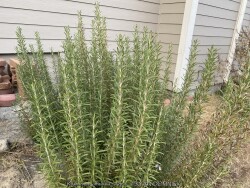

Rosemary is one of the most well-known herbal and edible plants. It features grayish green aromatic and evergreen foliage with small white flowers. Blooming is usually short-lived and not a main reason to grow Rosemary. This plant is native to Mediterranean climates with average moisture in the summer and dry, mild winters. Because of its heritage, it resents cold wet winters and needs well-drained sandy, silty, or rocky soil. In the short term, it will typically grow in any soil during the summer making it very useful even as an annual. In Kansas landscapes, it is commonly used as an annual or short-lived perennial with winter kill (below 0 to -10 degrees F) being it's number one enemy. It does not have very good ability to come back from the lower portion of the stem or root system like other perennials after winter-kill. Root rot is also likely when placed in poor draining soil and sometimes even in rich garden soil. Summer heat not a problem; to have a chance of survival as a perennial, plant in a protected area on a South or West wall. Rosemary is actually a woody shrub in mild zone 8 and 9 climates and grown like a in perennial in zone 6/7. When grown as a perennial, every so often you do need to trim it back to a few inches off the ground. Rosemary combines nicely with any other flowers or where needing a perennial with evergreen winter color. In Kansas, Rosemary is commonly grown as an outdoor patio plant that you move in for the winter to enjoy fresh clippings. When grown that way, remember that Rosemary is cold hardy to about 0 degrees F so you can skip the first few freezes before moving it in if you forget. This delay is probably beneficial because if you keep it in the house too long especially with poor light it will display poor quality elongated growth and die. Keep in a bright window and do not let it dry out completely. Strangely enough being from a desert climate, rosemary doesn't really warn you by wilting, if the soil gets extremely dry for too long, it just suddenly dries up and dies. Despite all of these pointers, rosemary is very easy to overwinter in the house when placing back out in the following spring. 'Arp' is exceptionally cold hardy; possibly the most cold hardy rosemary being a treu perennial in zone 6 with dark blue hummingbird feeding flowers.
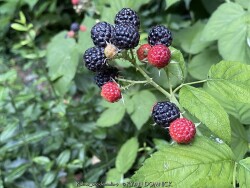

Raspberry (Rubus occidentalis) is an "easy to grow" edible fruit that is worth growing in Kansas. Store-bought raspberries are expensive and don't taste as good as garden grown fruits. All cultivars of raspberries have perennial roots, but most top shoots only live for two years. (meaning shoots grow in the first growing season and fruits grow on those shoots during the second growing season) The cycle is repeated; maintenance involves removing old canes after decline or death. Raspberries are vigorous and can be locally invasive in the garden but rarely invasive in the wild. They propagate by basal shoots (also known as suckers) spreading some distance from the main plant. After establishment, it is high maintenance if it has already filled the space and you don't want it to spread any further so plan accordingly. In the landscape, raspberry and blackberry mix well into garden designs with ornamental plants as long as you create it's own area (like a background fence to train plants on) The main difference between raspberry and blackberry are that the fruit releases from the raspberry differently. The "torus" or inside center of the fruit is hollow and releases from the stem with raspberry. With Blackberry, the "torus" or center "picks with" the fruit giving a solid fruit to eat. (just in case you have always wondered) Native Black Raspberry (Rubus occidentalis) is a true native plant to Kansas lightly shaded woods, open moist prairies, disturbed areas (especially those that are logged or cut), and near streams and lakes, trails or roadways. Ripe fruit is black instead of red. Fruit production is rather brief compared to commercially available varieties (one big flush of fruits ripen for a couple weeks and that's it) Foliage is bluish-green with powdery white flocked backsides and irridescent bluish-purple stems add nice ornamental value! Also called black cap raspberry.
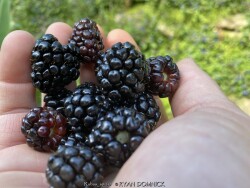

Blackberry (Rubus sp.) is an "easy to grow" edible fruit that is worth growing in Kansas. Store-bought blackberries are expensive and don't taste as good as garden grown fruits. All cultivars of blackberries have perennial roots, but most top shoots only live for two years. (meaning shoots grow in the first growing season and fruits grow on those shoots during the second growing season) The cycle is repeated; maintenance involves removing old canes after decline or death. Raspberries are vigorous and can be locally invasive in the garden but rarely invasive in the wild. They propagate by basal shoots (also known as suckers) spreading some distance from the main plant. After establishment, it is high maintenance if it has already filled the space and you don't want it to spread any further so plan accordingly. In the landscape, raspberry and blackberry mix well into garden designs with ornamental plants as long as you create it's own area (like a background fence to train plants on) The main difference between raspberry and blackberry are that the fruit releases from the raspberry differently. The "torus" or inside center of the fruit is hollow and releases from the stem with raspberry. With Blackberry, the "torus" or center "picks with" the fruit giving a solid fruit to eat. (just in case you have always wondered) Our supplier, Forrest Keeling nursery, has released an array of improved hybrids and varieties available.
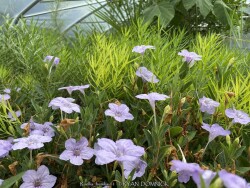

Wild petunia is a native wildflower with bright lavender-pink flowers occurring in a wide swath from Texas to Michigan and the mid-west including Kansas Native habitat includes poor and rich soil prairies and lightly shaded woods. This wildflower also colonizes readily, will grow under the lawnmower blades and can be found along state highways. Foliage is often green and attractive. Flowering is relatively short at 2 to 4 weeks but gorgeous while it happens. Seed pods develop eventually break open to release seed. In the landscape, Wild petunia can be used in any average to dry soil situation including berms, hot south or west side of the house, or any other full to part-sun area. These will grow in poor rocky, sandy or clayish soils and even rich organic soils with slightly increased root rot susceptibility. With our average 40 inches of rain per year in eastern Kansas, extra irrigation is not recommended. Wild petunia can grow and flower in part shade even dry shades situations with a few hours of angled sun. It can also be planted in parking lot medians and other hell strips as a very durable groundcover as witnessed on Nebraska University's Lincoln campus. Combine with any other flower colors except lavender. There is quite a lot of diversity within the species so plants from different locales will have different foliage adapted to the site. Un-wanted self-seeding can be a problem in the garden if you do not use mulch. This is generally encouraged in wild gardens, however.
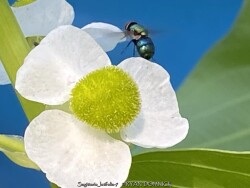

>>>>>This plant is usually grown as a bog plant needing constantly moist soil rich in organic matter. As a rain garden plant, it will thrive is a depressed area in the landscape that collects rain water from a roof during spring and summer periods of rain but then go dormant if the water hole dries out completely. For the home garden, the species is generally too aggressive to mix with other plants
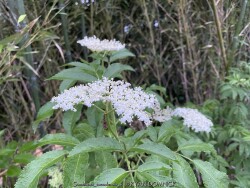

American Elderberry (Sambucus canadensis) is a large spreading shrub with interesting foliage, white flowers and deep purple blackberries. Elderberry is native to a large part of the US (Eastern Midwestern and Northern areas) including Kansas. Large white flower clusters attract bees and other kinds of pollinators for about a month in June. Decent growth will occur in both sun or full shade but growth is open and coarse textured either way. Flowering and fruiting will diminish with increasing shade but not go away completely. American elderberry tolerates a wide variety of wet to dry soils but prefers rich, moist, slightly acidic soil. Elderberry grows fastest and rich well drained soils but may become too fast and agressive. To slow down or eliminate this suckering tendency, plant in a more stressful sites such as dry shade, dry sunny areas, tight heavy clay soils, or non-irrigated areas. However, if you want absorbent amounts of fruit and spread, designate a large area with rich soil regular water in your garden. A favorite use in the landscape is filling the niche of a large flowering shrub in full shade. Elderberry also makes a great mass planting belong roadways or wild areas. Large flowers and copious amounts of fruit make this a great wildlife friendly plant. As you may have already heard, elderberries may be harvested and processed into an array of juices, syrups, and products with immune system stimulating qualities. The raw fruit should be boiled before eaten. Select cultivars have been produced with drastically increased fruit yields. Although self-fertile, more fruit set occurs with cross-polination
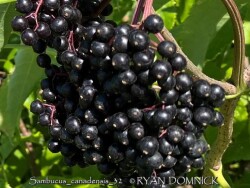

American Elderberry (Sambucus canadensis) is a large spreading shrub with interesting foliage, white flowers and deep purple blackberries. Elderberry is native to a large part of the US (Eastern Midwestern and Northern areas) including Kansas. Large white flower clusters attract bees and other kinds of pollinators for about a month in June. Decent growth will occur in both sun or full shade but growth is open and coarse textured either way. Flowering and fruiting will diminish with increasing shade but not go away completely. American elderberry tolerates a wide variety of wet to dry soils but prefers rich, moist, slightly acidic soil. Elderberry grows fastest and rich well drained soils but may become too fast and agressive. To slow down or eliminate this suckering tendency, plant in a more stressful sites such as dry shade, dry sunny areas, tight heavy clay soils, or non-irrigated areas. However, if you want absorbent amounts of fruit and spread, designate a large area with rich soil regular water in your garden. A favorite use in the landscape is filling the niche of a large flowering shrub in full shade. Elderberry also makes a great mass planting belong roadways or wild areas. Large flowers and copious amounts of fruit make this a great wildlife friendly plant. As you may have already heard, elderberries may be harvested and processed into an array of juices, syrups, and products with immune system stimulating qualities. The raw fruit should be boiled before eaten. Select cultivars have been produced with drastically increased fruit yields. We have tested the following varieties in Lawrence, KS, all passing with flying colors: Bob Gordon, Wyldewood, and York. Although self-fertile, more fruit set occurs with cross-polination.
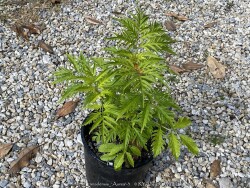

***Shrub descriptions available with future update!***
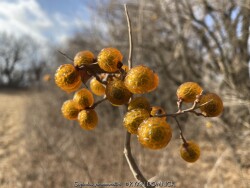

***Tree descriptions available with future update!***
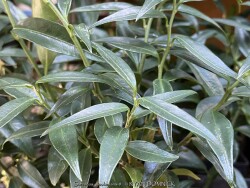

Himalayan Sweet Box (Sarcococca hookeriana) is planted for its evergreen dark green foliage and white flowers. Foliage maintains well all year provided that certain cultural conditions are met. Native to shaded mountain areas in forests, valleys or along streams in the Himalayas, it needs moist soil rich in organic matter avoiding too much clay. It is somewhat drought tolerant once established. If low temperatures hit -5 to -10 degrees F, foliage finally dies back to the ground and re-emerges in early spring. Generally this plant can decline after a few years of Kansas climate but is worth a try in perfect soils in well-tended shade gardens. If low temperatures hit -10 degrees F, it may kill an un-mulched plant; protect any zone 6 plant with thick layer of mulch. Lack of moisture and competition with weeds seem to be an issue but it survives just fine. Growth is extremely slow. This is one of the most deep shade tolerant plants available.
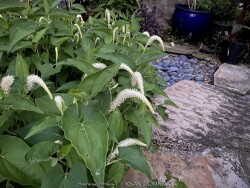

Lizards Tail Water Plant (Saururus cernuus) is a herbaceous perennial that features clean green foliage and white flowers that bloom in the summer months. Leaves are heart-shaped (cordate) and alternate along the stem of the plant. When the leaves are crushed they release a citrus or sassafras aroma. The native range covers much of the eastern United States including eastern Kansas. This plant is often grown as a marginal aquatic plant in standing water or as a potted plant in water gardens. It can also grow as a bog plant needing constantly moist soil rich in organic matter. As a rain garden plant, it will thrive is a depressed area in the landscape that collects rain water from a roof during spring and summer periods of rain but then go dormant if the water hole dries out completely. It may also be grown in average garden soils provided extra water is supplied during droughts. For the home garden, the species is generally too aggressive to mix with other plants. This can also be a problem in a water garden if you fail to divide this plant after several years. Lizard's Tail is a rare water garden plant that can also tolerate shading by larger trees.
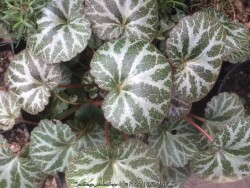

Hardy Strawberry Geranium, is also known as Saxifraga stolonifera
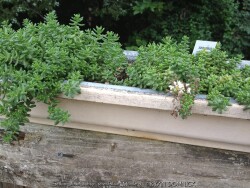

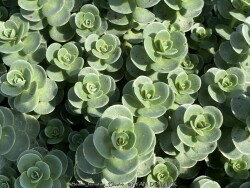

Native White Sedum, is also known as Sedum ternatum
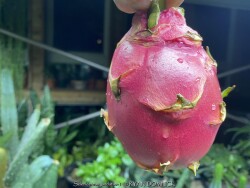

Dragon Fruit cacti are grown for delicious nutritious fruits. This tropical jungle cactus has a few requirements in order to thrive but nothing too hard. Give them bright indirect light and water only when dry. They are usually grown as a house plant in Kansas but can be moved outside if kept in part shade to shade. Leaves can sunburn but morning or filtered sun is ok! Dragon Fruit, like all true cacti, originates in the Americas. It is a sprawling or vining, terrestrial or epiphytic cactus. They climb trees and walls by use of aerial roots and can reach a height of 30 feet in the wild. Protect from temperatures below 45 degrees F and move into a bright window over the winter with no watering. As a winter house plant, it will look presentable all winter long with just a few waterings. Repotting may or may not be needed depending on how large you want the plant to grow; plants can continue to grow in the same pot for years. If repotting, make sure to use a sharp draining highly organic cactus mix with plenty of sand and perlite. This is relatively uncommon plant never seen at the big box stores and will command a higher price than most other houseplants. Plants are usually grown in hanging baskets and take up alot of space. Fruit may or may not occur in this climate; I have seen flowering but not fruit.
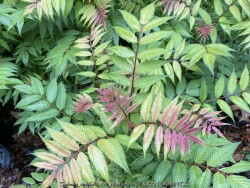

>>>>>Fabulously funky! Mr. Mustard boasts extraordinarily colorful foliage - yellow, orange, red, pink, and lime green meld together in springtime to make a truly memorable show. By summertime, the foliage mellows to a vibrant Kelly green and complements the fabulous creamy white flowers. These large, astilbe-like blooms attract butterflies and pollinators and its suckering habit lends a naturalized look to any garden. With some annual pruning, it easily keeps its mounded habit, suiting it perfectly for mixed beds. >>>>>>All Proven Winners® plants are legally propagated, healthy and vigorous, true to name, and tagged with color pictures and growing information. >>>>>>>>Ultra cold-hardy plants from northern climates normally dislike our long hot humid summers; although we are on the Southern edge of this plants adaptability, it still survives reasonably well here. Look for a cold microclimate planting location such as East or North exposure.>>>>>
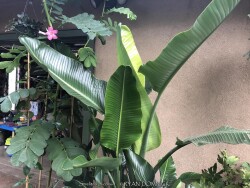

White Bird of Paradise (Tropical), is also known as Strelitzia nicolai
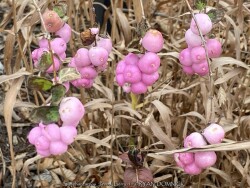

Coralberry (Symphoricarpos orbiculatus) is a spreading dwarf shrub native to much of the central and eastern United States including Kansas. It features mint green leaves that remain attractive all summer. Light pink flowers are barely noticeable but attractive upon close inspection. Ornamental clusters of magenta berries in the fall are the main attraction! The berries are very freeze-hardy clinging onto the leafless stems throughout most of the winter regardless of the minimum temperatures. This creates quite a show providing excellent color and interest to the winter landscape. While edible for some birds including robins, they seem to avoid the fruits unless it's a last resort. Coralberry is commonly grown as a spreading groundcover shrub for difficult areas. It will grow in full sun or full shade in medium to dry soils including dry-shade. It tolerates moist soil and floods for short periods of time. Fall leaf color is non-existent but ok because of the berry display. A brief window of time exists in the fall where the plant has beautiful green foliage and contrasting magenta berries at the same time. In the landscape, it is commonly used as large mass planting on hills. Because of its tolerance for adverse conditions including poor soil and rock, it is often one of the last resort plants that will survive in certain areas. It competes well under large shade trees and helps absorb leaf litter allowing it to break down and add nutrients back to the soil. This plant also does well in full sun; berry density is much greater in full sun. Plants can also be planted on the north side of a house, being extremely cold hardy with no winterkill. Another great spot is planting on top of a retaining wall allowing it to cascade down. We do not recommend planting in small areas or in spaces that it will overrun neighboring plants. It only spreads above ground as horizontally growing stems touch the ground and root. This does make maintenance easier to control the spread of the plant versus digging out rhizomes. Considered one of the best plants for solving your most difficult dry-shade landscape challenges. Proud Berry Pink Coralberry (Symphoricarpos 'Proud Berry') is a Proven Winners® selection that has much larger pink berries in large clusters. Fruit lasts into December but is quicker to dessicate than the true native magenta coralberry. All Proven Winners® plants are legally propagated, healthy and vigorous, true to name, and tagged with color pictures and growing information.
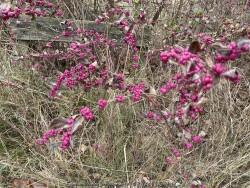

Coralberry (Symphoricarpos orbiculatus) is a spreading dwarf shrub native to much of the central and eastern United States including Kansas. It features mint green leaves that remain attractive all summer. Light pink flowers are barely noticeable but attractive upon close inspection. Ornamental clusters of magenta berries in the fall are the main attraction! The berries are very freeze-hardy clinging onto the leafless stems throughout most of the winter regardless of the minimum temperatures. This creates quite a show providing excellent color and interest to the winter landscape. While edible for some birds including robins, they seem to avoid the fruits unless it's a last resort. Coralberry is commonly grown as a spreading groundcover shrub for difficult areas. It will grow in full sun or full shade in medium to dry soils including dry-shade. It tolerates moist soil and floods for short periods of time. Fall leaf color is non-existent but ok because of the berry display. A brief window of time exists in the fall where the plant has beautiful green foliage and contrasting magenta berries at the same time. In the landscape, it is commonly used as large mass planting on hills. Because of its tolerance for adverse conditions including poor soil and rock, it is often one of the last resort plants that will survive in certain areas. It competes well under large shade trees and helps absorb leaf litter allowing it to break down and add nutrients back to the soil. This plant also does well in full sun; berry density is much greater in full sun. Plants can also be planted on the north side of a house, being extremely cold hardy with no winterkill. Another great spot is planting on top of a retaining wall allowing it to cascade down. We do not recommend planting in small areas or in spaces that it will overrun neighboring plants. It only spreads above ground as horizontally growing stems touch the ground and root. This does make maintenance easier to control the spread of the plant versus digging out rhizomes. Considered one of the best plants for solving your most difficult dry-shade landscape challenges.
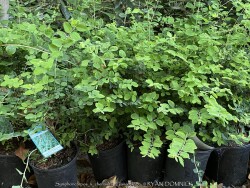

Coralberry (Symphoricarpos orbiculatus) is a spreading dwarf shrub native to much of the central and eastern United States including Kansas. It features mint green leaves that remain attractive all summer. Light pink flowers are barely noticeable but attractive upon close inspection. Ornamental clusters of magenta berries in the fall are the main attraction! The berries are very freeze-hardy clinging onto the leafless stems throughout most of the winter regardless of the minimum temperatures. This creates quite a show providing excellent color and interest to the winter landscape. While edible for some birds including robins, they seem to avoid the fruits unless it's a last resort. Coralberry is commonly grown as a spreading groundcover shrub for difficult areas. It will grow in full sun or full shade in medium to dry soils including dry-shade. It tolerates moist soil and floods for short periods of time. Fall leaf color is non-existent but ok because of the berry display. A brief window of time exists in the fall where the plant has beautiful green foliage and contrasting magenta berries at the same time. In the landscape, it is commonly used as large mass planting on hills. Because of its tolerance for adverse conditions including poor soil and rock, it is often one of the last resort plants that will survive in certain areas. It competes well under large shade trees and helps absorb leaf litter allowing it to break down and add nutrients back to the soil. This plant also does well in full sun; berry density is much greater in full sun. Plants can also be planted on the north side of a house, being extremely cold hardy with no winterkill. Another great spot is planting on top of a retaining wall allowing it to cascade down. We do not recommend planting in small areas or in spaces that it will overrun neighboring plants. It only spreads above ground as horizontally growing stems touch the ground and root. This does make maintenance easier to control the spread of the plant versus digging out rhizomes. Considered one of the best plants for solving your most difficult dry-shade landscape challenges. Symphoricarpos x chenaultii 'Hancock' in a dwarf variety maxing out at 18-24" tall.
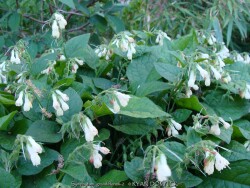

Dry Shade Comfrey / Large-Flowered Comfrey (Symphytum grandiflorum) is a perennial native to Europe with textured sandpapery green leaves and light yellow flowers. It spreads by creeping rhizomes and forms an attractive groundcover. Foliage is quite dense forming a tight weed resistant covering. Comfrey prefers rich average to moist well-drained soils with part sun to full shade. However, being a tolerant plant, is very adaptable to both dry and moist locations and will grow quite nicely in dry shade. It is not particular as to soil type or pH. and is highly tolerant of urban pollution and will even thrive in inner city environments. There is virtually no maintenance unless you want to mow down the dead foliage in the winter. It is also suggested to deadhead the flowers after blooming as they are not attractive. But if you don't, they will die back on their own and get swallowed up by the foliage. In addition to being a great perennial for your landscape, this comfrey may have herbal uses as well. There are no pest, disease, or browser problems. Considered one of the best plants for solving your most difficult dry-shade landscape challenges. The blue variety, Symphytum grandiflorum 'Hidcote Blue', has more of a blue green foliage and light blue flowers on taller flower spikes. Spread is also more rapid and sometimes to the point of aggressive and rich moist soil. Comfrey is a great underused plant worthy of more wide scale use in the landscape. Dry Shade Comfrey has persisted through over a decade in our Lawrence, KS display garden with no problems.
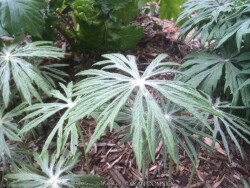

Japanese Shredded Umbrella Plant (Syneilesis aconitifolia) is a perennial with bright green dissected leaves cascade downward like an umbrella. Emerging foliage is covered with a unique white fur. It spreads very slowly by creeping rhizomes that form a tight clump after many years. Fine-textured foliage is quite dense; it forming a tight weed resistant covering. White flowers on mauve pink calyxes tower above the foliage in midsummer but are not especially attractive unless viewed up close. Some gardeners cut the flowers promptly to avoid distraction from the amazing foliage. Japanese Shredded Umbrella Plant prefers rich average to moist well-drained soils with morning sun to full shade. However, being a tolerant plant, is adaptable to both dry and moist locations and will grow quite nicely in mild dry shade. It is not particular as to soil type or pH. There is virtually no maintenance accept cutting down in fall after the first hard freeze. It is also suggested that if allowing flowering to occur, to deadhead the flowers after blooming as they are not attractive either. There are no pest, disease, or browser problems. This plant is a great underused specimen for the shade garden worthy of more wide scale use in the landscape. Having persisted in our Lawrence, KS display garden with no problems for over a decade, this is a "must have" if and when available to purchase!
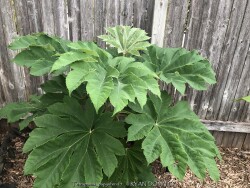

Rice Paper Plant (Tetrapanax papyrifer) is a hardy tropical with large palmate leaves up to 24" across. In warmer zones and in its native habitat in Taiwan, Tetrapanax is a large shrub or small tree with white flowers produced in the fall. However in our Lawrence Kansas zone 6a climate, Tetrapanax is killed down to the ground each year like crapemyrtles and butterfly bush. A thick mulch is appreciated when young but not needed on established plantings. Tetrapanax is not picky about soils or moisture but will display fastest growth in rich, moist, well-drained areas in full sun. Tetrapanax will also tolerate almost full shade when established. Because it spreads by rhizomes, be sure to allow plenty of space or have control methods in place. Generally, chopping off shoots as they emerge as easy enough. Another word of caution is that Tetrapanax contains a white powdery-like cottony substance on near stems and back sides of leaves. This can cause eye and throat irritation so be careful when cutting back to not rub off the dust (or do so up-wind). Tetrapanax is a very rare plant in cultivation but can also be seen at the Wichita botanical gardens, Botanica. There is a giant form called Tetrapanax papyrifer 'Steroidal Giant' available at Plant Delights Nursery in North Carolina with leaves up to 3 feet wide and less spreading but we have not been able to procure or establish this plant in our Lawrence, KS garden. In our trial gardens in Lawrence, KS (zone 6a), three established mulched specimens of Tetrapanax papyrifer have survived for over 10 years including -17 degrees F in 2021. During that arctic blast of February, 2021, lows down to -17 degrees F on Feb 16th, 2021 were recorded. The longevity of this cold blast was also impressive: 10 days on a row with highs of 10-15 degrees F or lower, 8 nights of lows in the single digits and negatives, and 36 straight hours of 0 degrees F and mostly lower. It can also be grown as a potted patio plant; move into a cold garage or basement over the winter with minimal watering. Allow to go dormant as needed with little care, just cut off dead foliage and place back out in April or May with a time-release fertilizer.
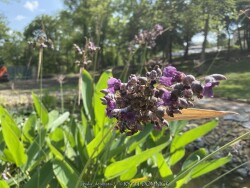

>>>>>This plant is usually grown as a bog plant needing constantly moist soil rich in organic matter. As a rain garden plant, it will thrive is a depressed area in the landscape that collects rain water from a roof during spring and summer periods of rain but then is amazingly drought tolerant if the water hole dries out.